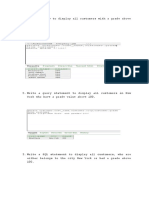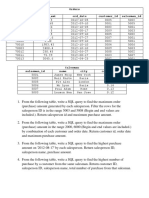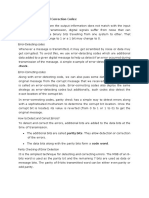0 ratings0% found this document useful (0 votes)
10 viewsOracle SQL Excercise 4 - Aggregate Functions
The document provides 20 SQL statements to analyze sample tables containing order and customer data. The statements include queries to find total, average, minimum, maximum purchase amounts; counts of salesmen, customers, orders; highest purchase amounts grouped by customer ID, date, city; and counts filtered on date ranges, IDs, and purchase amount thresholds.
Uploaded by
aditya infaCopyright
© © All Rights Reserved
Available Formats
Download as DOCX, PDF, TXT or read online on Scribd
0 ratings0% found this document useful (0 votes)
10 viewsOracle SQL Excercise 4 - Aggregate Functions
The document provides 20 SQL statements to analyze sample tables containing order and customer data. The statements include queries to find total, average, minimum, maximum purchase amounts; counts of salesmen, customers, orders; highest purchase amounts grouped by customer ID, date, city; and counts filtered on date ranges, IDs, and purchase amount thresholds.
Uploaded by
aditya infaCopyright
© © All Rights Reserved
Available Formats
Download as DOCX, PDF, TXT or read online on Scribd
You are on page 1/ 4
1.
Write a SQL statement to find the total purchase amount of all
orders.
Sample table : orders
SELECT SUM(purch_amt) FROM orders;
2. Write a SQL statement to find the average purchase amount of
all orders.
Sample table : orders
SELECT AVG(purch_amt) FROM orders;
3. Write a SQL statement to find the number of salesmen
currently listing for all of their customers.
Sample table : orders
SELECT COUNT(DISTINCT (salesman_id)) FROM orders;
4. Write a SQL statement know how many customer have listed
their names.
Sample table : customer
SELECT COUNT(DISTINCT (cust_name)) FROM customer;
5. Write a SQL statement find the number of customers who gets
at least a gradation for his/her performance.
Sample table : customer
SELECT COUNT(grade) FROM customer;
6. Write a SQL statement to get the maximum purchase amount
of all the orders.
Sample table : orders
SELECT MAX(purch_amt) FROM orders;
7. Write a SQL statement to get the minimum purchase amount
of all the orders.
Sample table : orders
SELECT Min(purch_amt) FROM orders;
8. Write a SQL statement which selects the highest grade for
each of the cities of the customers.
Sample table : customer
SELECT MAX(grade),city FROM customer GROUP BY city;
9. Write a SQL statement to find the highest purchase amount
ordered by the each customer with their ID and highest purchase
amount.
Sample table : orders
SELECT customer_id, MAX(purch_amt) FROM orders GROUP BY
customer_id;
10. Write a SQL statement to find the highest purchase amount
ordered by the each customer on a particular date with their ID,
order date and highest purchase amount.
Sample table : orders
SELECT customer_id,ord_date MAX(purch_amt) FROM orders GROUP BY
customer_id,ord_date;
11. Write a SQL statement to find the highest purchase amount
on a date '2012-08-17' for each salesman with their ID.
Sample table : orders
SELECT salesman_id,max(purch_amt) FROM orders WHERE
ord_date =
TO_DATE(‘2012-08-17’,’yyyy-mm-dd’) GROUP BY salesman_id;
12. Write a SQL statement to find the highest purchase amount
with their ID and order date, for only those customers who have
highest purchase amount in a day is more than 2000.
Sample table : orders
SELECT customer_id,ord_date,MAX(purch_amt) FROM orders
WHERE purch_amt > 2000 GROUP BY customer_id,ord_date;
13. Write a SQL statement to find the highest purchase amount
with their ID and order date, for those customers who have
a higher purchase amount in a day is within the range 2000 and
6000.
Sample table : orders
SELECT customer_id, ord_date,MAX(purch_amt) FROM orders GROUP BY
customer_id,ord_date HAVING max(purch_amt) BETWEEN 2000 AND 6000;
14. Write a SQL statement to find the highest purchase amount
with their ID and order date, for only those customers who have a
higher purchase amount in a day is within the list 2000, 3000,
5760 and 6000.
Sample table : orders
SELECT customer_id, ord_date,MAX(purch_amt) FROM orders GROUP BY
customer_id,ord_date HAVING max(purch_amt) IN (2000,3000,5760,6000);
15. Write a SQL statement to find the highest purchase amount
with their ID, for only those customers whose ID is within the
range 3002 and 3007.
Sample table : orders
SELECT customer_id,MAX(purch_amt) FROM orders WHERE customer_id
BETWEEN 3002 AND 3007 GROUP BY customer_id;
16. Write a SQL statement to display customer details (ID and
purchase amount) whose IDs are within the range 3002 and 3007
and highest purchase amount is more than 1000.
Sample table : orders
SELECT customer_id,MAX(purch_amt) FROM orders WHERE customer_id
BETWEEN 3002 AND 3007 GROUP BY customer_id HAVING MAX(purch_amt) > 1000;
17. Write a SQL statement to find the highest purchase amount
with their ID, for only those salesmen whose ID is within the
range 5003 and 5008.
Sample table : orders
SELECT salesman_id,MAX(purch_amt) FROM orders WHERE salesman_id BETWEEN
5003 AND 5008 GROUP BY salesman_id;
18. Write a SQL statement that counts all orders for a date
August 17th, 2012.
Sample table : orders
SELECT COUNT(*) FROM orders WHERE ord_date =
TO_DATE(‘2012-08-17’, ‘yyyy-mm-dd’);
19. Write a SQL statement that counts the number of different
non NULL city values for salesmen.
Sample table : salesman
SELECT COUNT(city) FROM salesman WHERE city IS NOT NULL;
20. Write a query that counts the number of salesmen with their
order date and ID registering orders for each day.
Sample table : orders
SELECT salesman_id,ord_date, count(*) FROM orders GROUP BY salesman_id,ord_date;
You might also like
- Lahore Garrison University: Course Syllabus DescriptionNo ratings yetLahore Garrison University: Course Syllabus Description4 pages
- Oracle Group By Having Clause Exercises SolutionsNo ratings yetOracle Group By Having Clause Exercises Solutions6 pages
- Write A Query To Display All Customers With A Grade Above 100No ratings yetWrite A Query To Display All Customers With A Grade Above 10010 pages
- Prashant Tripathi (Ajay Kumar Garg Engineering College) SQL AssignemntNo ratings yetPrashant Tripathi (Ajay Kumar Garg Engineering College) SQL Assignemnt8 pages
- Student Name: Abdulaziz Bakhsh Student ID: 1543123 Database Lab 4No ratings yetStudent Name: Abdulaziz Bakhsh Student ID: 1543123 Database Lab 46 pages
- Snum Number (10) Primary Key, Sname Varchar2 (40) Not Null City Char (40, COMM NUMBER (10,2) )No ratings yetSnum Number (10) Primary Key, Sname Varchar2 (40) Not Null City Char (40, COMM NUMBER (10,2) )7 pages
- SQL Coding Question - Completed - FinalNo ratings yetSQL Coding Question - Completed - Final44 pages
- Most frequently asked SQL interview questions with their answersNo ratings yetMost frequently asked SQL interview questions with their answers2 pages
- Orders Ord - No Purch - Amt Ord - Date Customer - Id Salesman - IdNo ratings yetOrders Ord - No Purch - Amt Ord - Date Customer - Id Salesman - Id1 page
- DB2 11.1 for LUW: SQL Basic Training for Application DevelopersFrom EverandDB2 11.1 for LUW: SQL Basic Training for Application DevelopersNo ratings yet
- Flash Memory Summit 2019 Persistent Memory and NvdimmsNo ratings yetFlash Memory Summit 2019 Persistent Memory and Nvdimms45 pages
- 3042 - New ABARS Related Products For Improved Disaster Recovery EffectivenessNo ratings yet3042 - New ABARS Related Products For Improved Disaster Recovery Effectiveness32 pages
- Micro Project: Maharashtra State Board of Technical Education100% (1)Micro Project: Maharashtra State Board of Technical Education15 pages
- MD070 SSN Shipping and RMA Receipt Customization V1 1No ratings yetMD070 SSN Shipping and RMA Receipt Customization V1 142 pages
- Chapter Two: Building Blocks of AndroidNo ratings yetChapter Two: Building Blocks of Android28 pages
- Optional Exercise (Linux Terminal Commands)No ratings yetOptional Exercise (Linux Terminal Commands)12 pages
- Workshop Practice 1: Reading and Manipulating Short ReadsNo ratings yetWorkshop Practice 1: Reading and Manipulating Short Reads16 pages
- Symantec DLP 14.6 Server FlexResponse Platform Developers GuideNo ratings yetSymantec DLP 14.6 Server FlexResponse Platform Developers Guide54 pages
- Bachelor of Science (B.SC.) Semester-III (C.B.S.) Examination COMPUTER SCIENCE (Operating Systems) Paper-IINo ratings yetBachelor of Science (B.SC.) Semester-III (C.B.S.) Examination COMPUTER SCIENCE (Operating Systems) Paper-II2 pages
- Lahore Garrison University: Course Syllabus DescriptionLahore Garrison University: Course Syllabus Description
- Write A Query To Display All Customers With A Grade Above 100Write A Query To Display All Customers With A Grade Above 100
- Prashant Tripathi (Ajay Kumar Garg Engineering College) SQL AssignemntPrashant Tripathi (Ajay Kumar Garg Engineering College) SQL Assignemnt
- Student Name: Abdulaziz Bakhsh Student ID: 1543123 Database Lab 4Student Name: Abdulaziz Bakhsh Student ID: 1543123 Database Lab 4
- Snum Number (10) Primary Key, Sname Varchar2 (40) Not Null City Char (40, COMM NUMBER (10,2) )Snum Number (10) Primary Key, Sname Varchar2 (40) Not Null City Char (40, COMM NUMBER (10,2) )
- Most frequently asked SQL interview questions with their answersMost frequently asked SQL interview questions with their answers
- Orders Ord - No Purch - Amt Ord - Date Customer - Id Salesman - IdOrders Ord - No Purch - Amt Ord - Date Customer - Id Salesman - Id
- DB2 11.1 for LUW: SQL Basic Training for Application DevelopersFrom EverandDB2 11.1 for LUW: SQL Basic Training for Application Developers
- Flash Memory Summit 2019 Persistent Memory and NvdimmsFlash Memory Summit 2019 Persistent Memory and Nvdimms
- 3042 - New ABARS Related Products For Improved Disaster Recovery Effectiveness3042 - New ABARS Related Products For Improved Disaster Recovery Effectiveness
- Micro Project: Maharashtra State Board of Technical EducationMicro Project: Maharashtra State Board of Technical Education
- MD070 SSN Shipping and RMA Receipt Customization V1 1MD070 SSN Shipping and RMA Receipt Customization V1 1
- Workshop Practice 1: Reading and Manipulating Short ReadsWorkshop Practice 1: Reading and Manipulating Short Reads
- Symantec DLP 14.6 Server FlexResponse Platform Developers GuideSymantec DLP 14.6 Server FlexResponse Platform Developers Guide
- Bachelor of Science (B.SC.) Semester-III (C.B.S.) Examination COMPUTER SCIENCE (Operating Systems) Paper-IIBachelor of Science (B.SC.) Semester-III (C.B.S.) Examination COMPUTER SCIENCE (Operating Systems) Paper-II

























































































